2005/11/28
2005/11/27
Thailand
来月22日から10日間タイに居ます。二回目です。去年お盆の間にもタイに居たけど、梅雨だったからあまり観光しなかった。そのうえ、あそこで撮られた写真のほとんどは無くなっちゃった。パソコンが壊れて、いまEメールで送った写真だけしかない。今回まだ予定をしてないけど、始めにバンコクに行ってカオサン通りのどこかの安いホテルに泊まる。後はDougって言うバンコクに住む友達がちょっと案内してくれて、もっといいホテルを進めるかも知れない。そして時間があったらカンボジアのアンコールワットにも生きたい。母が送ったガイドブックがすぐ来たらよかった。
2005/11/26
名古屋の紅葉

Kouyou means "autumn leaves" or, more literally, "red leaves." Certain parts of Japan have very famously beautiful autumn leaves, and like cherry-blossom-viewing in the spring, people will sometimes travel just to see the fall colors, particularly in Kyoto.
Kouyou significa "folhas de outono," ou literalmente "folhas vermelhas." Certas regiões do Japão tem folhas muito bonitas, até que, como os flores de cereja na primavera, gente as vezes viajam só para ver a folhagem, especialmente em Kyoto.

I, however, cannot afford to go to Kyoto right now, but I did finally make it over to Nagoya today, a 40-minute bullet train ride away, and there were some very nice autumn colors around Nagoya castle.
Agora não tenho dinheiro para visitar Kyoto agora, mas fui hoje pela primeira vez para Nagoya, que leva 40 minutos de trem bala. Lá tem uns cores bonitos nos arredores do castelo de Nagoya.

Here is the castle itself, with Nagoya Noh Theatre on the left:
Eis o castelo aqui, com o Teátro de Noh de Nagoya ao isquerdo:
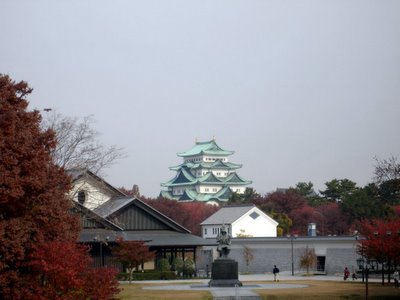
Nagoya castle is considerably bigger than Hamamatsu's, but was built by the same guy, Ieyasu Tokugawa. (This statue is not him, by the way.)
 Nagoya castle was built on level ground, has an outer wall and an inner one, with a moat outside and another between the walls.
Nagoya castle was built on level ground, has an outer wall and an inner one, with a moat outside and another between the walls.  The main castle and several surrounding buildings were destroyed by fire caused by bombing during World War II, though some of the outer towers remained intact. The main tower and annex were restored in the 1950's, and the city is currently fund-raising to rebuild the adjacent palace as well.
The main castle and several surrounding buildings were destroyed by fire caused by bombing during World War II, though some of the outer towers remained intact. The main tower and annex were restored in the 1950's, and the city is currently fund-raising to rebuild the adjacent palace as well. Inside the castle now is a small museum with reproductions of how life in Nagoya would have been in the Edo period, and also some old photographs of the grounds before they were destroyed. They don't allow people to take photographs inside the museum.
Inside the castle now is a small museum with reproductions of how life in Nagoya would have been in the Edo period, and also some old photographs of the grounds before they were destroyed. They don't allow people to take photographs inside the museum.Vou explicar em português tambêm. Cheque de novo mais tarde se quiser ler.
2005/11/23
Mom Milk
I discovered a really big 100 yen shop way down my street. The selection was pretty impressive, especially these notebooks: Click to enlarge.



Café tem cú?!? Quem sabia?
And there were lots of cards too. Look out Hallmark!

Is your life complete?

"I'm glad to know you're fine. That is about all I want to tell you this time."

A world of kittens in macaroni would be a fantasy indeed!

A card for every occasion!

You cannot cancel happiness. What can only be done now. You cannot cancel happiness.
This one is a card too, believe it or not.



Café tem cú?!? Quem sabia?
And there were lots of cards too. Look out Hallmark!

Is your life complete?

"I'm glad to know you're fine. That is about all I want to tell you this time."

A world of kittens in macaroni would be a fantasy indeed!

A card for every occasion!

You cannot cancel happiness. What can only be done now. You cannot cancel happiness.
This one is a card too, believe it or not.
西鹿島
Português em baixo
 Hamamatsu has a population of about 800,000 now, up 200,000 from last year due to the large annexation which occurred in July or so. This is a phenomenon which is happening all over Japan recently. I recall the same thing happening in Tottori last year. One reason is that if a city reaches one million inhabitants, it can become a candidate to receive the status of "designated city," which would give it more autonomy, more independence from the rules of
Hamamatsu has a population of about 800,000 now, up 200,000 from last year due to the large annexation which occurred in July or so. This is a phenomenon which is happening all over Japan recently. I recall the same thing happening in Tottori last year. One reason is that if a city reaches one million inhabitants, it can become a candidate to receive the status of "designated city," which would give it more autonomy, more independence from the rules of  the prefectural government. In Shizuoka prefecture, Hamamatsu and Shizuoka are in a sort of race to one million, with Hamamatsu now in the lead. Hamamatsu is Japan's fifteenth largest city by population, but it has absorbed so many small, surrounding communities that it is now the third largest city in Japan
the prefectural government. In Shizuoka prefecture, Hamamatsu and Shizuoka are in a sort of race to one million, with Hamamatsu now in the lead. Hamamatsu is Japan's fifteenth largest city by population, but it has absorbed so many small, surrounding communities that it is now the third largest city in Japan  in terms of area, following only Tokyo and Osaka. As a result, Hamamatsu has a lot of rural places within its city limits.
in terms of area, following only Tokyo and Osaka. As a result, Hamamatsu has a lot of rural places within its city limits.So today, because I hadn't ridden it before, I hopped on the Entetsu Akaden, the little red train from Shin-Hamamatsu station, and I rode it 30 minutes north to its terminus at Nishikajima Station, still within the city limits. There isn't a great deal to see there really, that I know of, but I took a few pictures at the side of the Tenryuu river. It's certainly a different side of Hamamatsu.

Devido à anexação em julho, a população de Hamamatsu subiu de 600.000 à 800.000. Anexação é um fenômeno que está acontecendo por toda parte do Japão porque, quando uma cidade chega à ter uma população de um milhão, é possível receber, como "cidade designada," mais autonomia do governo prefeitural.
 Aqui na prefeitura de Shizuoka, Hamamatsu e Shizuoka capital estão fazendo um tipo de competição, e agora Hamamatsu está ganhando. Por população, é a 15a maior cidade do Japão, mas já engoliu tantas pequenas comunidade vizinhas que é a terceira maior cidade por quilômetros quadrados, depois de só Tôkio e Osaka.
Aqui na prefeitura de Shizuoka, Hamamatsu e Shizuoka capital estão fazendo um tipo de competição, e agora Hamamatsu está ganhando. Por população, é a 15a maior cidade do Japão, mas já engoliu tantas pequenas comunidade vizinhas que é a terceira maior cidade por quilômetros quadrados, depois de só Tôkio e Osaka. 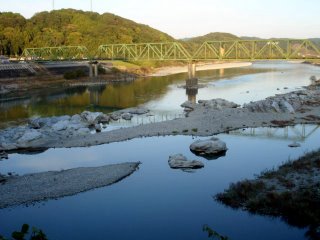 Como resultado, Hamamatsu inclui muitos lugares rurais.
Como resultado, Hamamatsu inclui muitos lugares rurais.Hoje fui explorar um pouco mais da cidade. Peguei pela primeira vez o Entetsu Akaden, o tremzinho vermelho que vai da estação Shin-Hamamatsu pro norte. Levou 30 minutos para ir para a estação Nishikajima, no fim da linha mas ainda dentro das limites da cidade. Parece que lá não há tanto para ver, mais tirei umas fotos ao lado do rio Tenryuu. É com certeza um lado diferente da cidade.
2005/11/22
Neighborhood #329
My street rules!-- The covered sidewalk that runs for several blocks has speakers that play music all day. This evening's selection: The Arcade Fire.
First time I've heard that here!
First time I've heard that here!
Visitas às escolas primárias

 I've been visiting elementary schools a lot lately. There are four of them that I visit with varying frequencies, though I never see a given class of kids more than once in a semester.
I've been visiting elementary schools a lot lately. There are four of them that I visit with varying frequencies, though I never see a given class of kids more than once in a semester. 
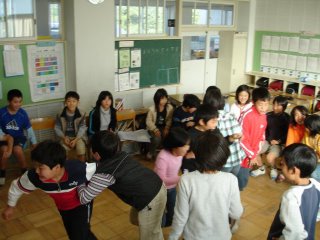 So far I've taught some fourth, fifth, and sixth grade classes, though I did have a Halloween party at one school in which the whole school participated (It's a tiny school, with as few as 10 students per grade.) All the kids have been super-genki, happy and full of energy. They get very excited about having a foreign teacher, and almost all of them participate very enthusiatically in the lesson, something which is quite a relief after teaching at junior high all the time. Regarding my base school, at least, I don't understand what it is that happens between sixth grade and the first year of junior high that turns down the overall enthusiasm so much and causes some of them to completely lose their ability to follow directions, rules, or common sense. These elementary school kids are great, and a few of them speak better English than anyone at either of my junior highs.
So far I've taught some fourth, fifth, and sixth grade classes, though I did have a Halloween party at one school in which the whole school participated (It's a tiny school, with as few as 10 students per grade.) All the kids have been super-genki, happy and full of energy. They get very excited about having a foreign teacher, and almost all of them participate very enthusiatically in the lesson, something which is quite a relief after teaching at junior high all the time. Regarding my base school, at least, I don't understand what it is that happens between sixth grade and the first year of junior high that turns down the overall enthusiasm so much and causes some of them to completely lose their ability to follow directions, rules, or common sense. These elementary school kids are great, and a few of them speak better English than anyone at either of my junior highs. Click to enlarge
2005/11/21
神原下
木曜と金曜は朝早く神原下って言うバス停から学校へ歩いて行く。


To get to one of my schools in the morning, I catch a bus at 6:50 and ride for 25 minutes, and then I have to walk for almost 20 minutes. The whole neighborhood is full of small farms. Above left is a field of green tea, for which this prefecture is famous. Above right is an orchard of mikan trees. Sometimes I see passing elementary kids looking for a mikan they can reach through the fence... Click to enlarge


They also grow a lot of lettuce, cabbage, kale, and other greens.


In the picture above on the right, the fields go right up to my school's grounds.

Nas quinta- e sexta-feiras tenho que andar à pé por 20 minutos entre a parada de ônibus e a escola onde trabalho. Tem muitas fazendas por lá de chá verde, produto famoso desta região, de mikan, um tipo de laranja pequena e doce, e também de lechuga e outros vegetales verdes.


To get to one of my schools in the morning, I catch a bus at 6:50 and ride for 25 minutes, and then I have to walk for almost 20 minutes. The whole neighborhood is full of small farms. Above left is a field of green tea, for which this prefecture is famous. Above right is an orchard of mikan trees. Sometimes I see passing elementary kids looking for a mikan they can reach through the fence... Click to enlarge


They also grow a lot of lettuce, cabbage, kale, and other greens.


In the picture above on the right, the fields go right up to my school's grounds.

Nas quinta- e sexta-feiras tenho que andar à pé por 20 minutos entre a parada de ônibus e a escola onde trabalho. Tem muitas fazendas por lá de chá verde, produto famoso desta região, de mikan, um tipo de laranja pequena e doce, e também de lechuga e outros vegetales verdes.
2005/11/20
Body Remover
Hamamatsu at night

The sun sets about 5PM these days... I had a long, rather chilly walk this evening and took these photos.
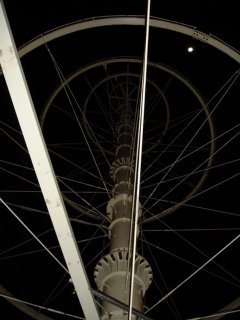
Can you guess what this is?

This is a long park-type space stretching north from Act Tower.
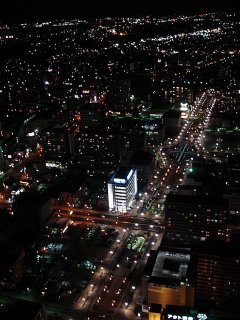
I went up to the 45th floor of Act Tower and took these last two. The one above is a bird's-eye view of the same park space in the previous picture.

The round building in the foreground is the main bus station. The blue and green building across from that is the Forte Building, which houses Hamamatsu's international center, among other things.
2005/11/17
Pachelbel, Pavlov, Muzak, and the catchy fish song...
Pachelbel's Canon will forever take me back to lunchtime in the Japanese school staff room, with children shitsureshimasu-ing in and out, and a tray of cold fried fish or little cold gray weiners in front of me, with a half-pint of that slightly cardboard-flavored Japanese milk. I'm not sure if that's what Pachelbel had in mind or not, but he is a sort of pre-recorded dinner bell for us every day at my base school, followed by some Verdi overture, before Vivaldi sounds the call to recess. In the afternoon we know it's cleaning time when Mendelsohn comes in with his Italian Symphony, and then that's it, until Bach starts up his Morning Meeting Brandenburg #3 at 8:05 the next day. Every day there it's the same program. I don't know if it's intended as some kind of Pavlovian conditioning to spur the kids into action or what. I almost think there would be an uproar if they played Pachelbel early in the morning-- kids might start circling their desks and getting out their chopsticks and placemats. At my other schools, a similar musical routine takes place, though each school has a different repertoire. One of my schools lets the kids listen to their Backstreet Boys or Orange Range or whatever, after the let's-get-ready-for-lunch tune is over, but an apparent over-arching rule of Japan is still at work: Everything must have a theme song.
It's not at all limited to schools. In the grocery store, in addition to the store jingles, you might find a little tape player next to the deli section looping a song about how korokke is watashi no oishii tomodachi, "my delicious friend," or the mushrooms in the produce section singing in a low voice, "Kinoko koko kono genki no ko..." The fish song was actually a real radio pop song several years ago. I can't understand much beyond "sakana sakana sakana" because of the high-pitched voices and my underdeveloped Japanese ability, but I am told that it extols the nutritional virtues of fish. Sickeningly catchy too.
One of my first impressions of Japan was in the bullet train station in Okayama, where every time a train arrives the intercom plays a Japanese-cutesy-ized Muzak version of "I've Been Working on the Railroad," all round bouncy synth tones. After being in Tottori for a while I noticed that not only would they play the same song on repeat in the train station for weeks at a time, but the special tourist bus which heads hourly for the sand dunes blares, everywhere it goes, a special cartoony theme song which was composed specifically as the Tottori Sand Dunes theme song. I can't recall it at the moment, but I'm sure if I heard it now, a flood of memories would come rushing back of random things I was thinking about when I heard the bus go by on a daily basis.
What is especially strange to me is the seeming ease with which the Japanese can become used to and/or completely tune out all the theme songs around. Particularly the people who work around them. The bus I ride every morning turns off its engine every time it stops for more than 10 seconds or so, and when it does it plays quite terrible toy-keyboard-demo-style Musak. If I were a bus driver I would never turn off the engine, because there are only about 10 tunes on the tape, or rather, about 20 seconds each of 10 tunes, after which it fades into the next tune. The tunes include "O Tannenbaum," "It's a Small World After All," John Lennon's "Imagine," one of those Peruvian folk tunes that you can hear played by traveling folk troupes in shopping malls across the US, and several tunes I recognize but don't know exactly. Since August, the same 10 tunes. I can assure you that "O Christmas Tree" and "It's a Small World" are hardly what I want to be listening to groggily every morning at 7 AM for months, and I'm sure the bus driver gets to listen to it well more often than I... Even worse, two well-known Best Buy-type electronics stores that I know, DeoDeo and Yamada Denki, both play a 45-second loop of their theme songs, complete with irritatingly high or low vocals, non-stop all day, every day. I cannot imagine working in a place like that, listening to that nonsense all the time. Even being in the store for 10 minutes, I tire of the repetition and start to dread having the ridiculous jingles in my head the rest of the day.
All I can say is that the public use of music is different here, and that sometimes my brain just screams music abuse! It snuggles right up against some other aural annoyances that abound, such as all the candidates just before election time who take advantage of the lack of noise ordinances, driving around in vans lined with loudspeakers blasting onegai shimasu's and introducing themselves over and over at peak volumes from 7 AM on any day of the week. (I actually once saw a helicopter with loudspeakers strapped on the bottom, flying low over Tottori-shi doing the same thing.) If I were Japanese, I would certainly vote for whichever candidate did the least of that particular type of campaigning...
Sometimes it just seems like unchecked noise pollution. The ping-ponging crosswalks. The beeping automatic doors. Talking ATMs. The sensor-automated speakers bleating irasshaimase and arigatou gozaimasu in certain restaurants and shops. The random gangs of minors intentionally drowning out all conversation by revving their motorcycle engine at full blast from one end of the street to the other, turning around and doing it again, legally immune from being pulled over by anything less than a roadblock (but that's a different story...)
Let's just says that Japan has different concepts of music and noise, and it sometimes draws the line between them in a different place than a Westerner otherwise might...
It's not at all limited to schools. In the grocery store, in addition to the store jingles, you might find a little tape player next to the deli section looping a song about how korokke is watashi no oishii tomodachi, "my delicious friend," or the mushrooms in the produce section singing in a low voice, "Kinoko koko kono genki no ko..." The fish song was actually a real radio pop song several years ago. I can't understand much beyond "sakana sakana sakana" because of the high-pitched voices and my underdeveloped Japanese ability, but I am told that it extols the nutritional virtues of fish. Sickeningly catchy too.
One of my first impressions of Japan was in the bullet train station in Okayama, where every time a train arrives the intercom plays a Japanese-cutesy-ized Muzak version of "I've Been Working on the Railroad," all round bouncy synth tones. After being in Tottori for a while I noticed that not only would they play the same song on repeat in the train station for weeks at a time, but the special tourist bus which heads hourly for the sand dunes blares, everywhere it goes, a special cartoony theme song which was composed specifically as the Tottori Sand Dunes theme song. I can't recall it at the moment, but I'm sure if I heard it now, a flood of memories would come rushing back of random things I was thinking about when I heard the bus go by on a daily basis.
What is especially strange to me is the seeming ease with which the Japanese can become used to and/or completely tune out all the theme songs around. Particularly the people who work around them. The bus I ride every morning turns off its engine every time it stops for more than 10 seconds or so, and when it does it plays quite terrible toy-keyboard-demo-style Musak. If I were a bus driver I would never turn off the engine, because there are only about 10 tunes on the tape, or rather, about 20 seconds each of 10 tunes, after which it fades into the next tune. The tunes include "O Tannenbaum," "It's a Small World After All," John Lennon's "Imagine," one of those Peruvian folk tunes that you can hear played by traveling folk troupes in shopping malls across the US, and several tunes I recognize but don't know exactly. Since August, the same 10 tunes. I can assure you that "O Christmas Tree" and "It's a Small World" are hardly what I want to be listening to groggily every morning at 7 AM for months, and I'm sure the bus driver gets to listen to it well more often than I... Even worse, two well-known Best Buy-type electronics stores that I know, DeoDeo and Yamada Denki, both play a 45-second loop of their theme songs, complete with irritatingly high or low vocals, non-stop all day, every day. I cannot imagine working in a place like that, listening to that nonsense all the time. Even being in the store for 10 minutes, I tire of the repetition and start to dread having the ridiculous jingles in my head the rest of the day.
All I can say is that the public use of music is different here, and that sometimes my brain just screams music abuse! It snuggles right up against some other aural annoyances that abound, such as all the candidates just before election time who take advantage of the lack of noise ordinances, driving around in vans lined with loudspeakers blasting onegai shimasu's and introducing themselves over and over at peak volumes from 7 AM on any day of the week. (I actually once saw a helicopter with loudspeakers strapped on the bottom, flying low over Tottori-shi doing the same thing.) If I were Japanese, I would certainly vote for whichever candidate did the least of that particular type of campaigning...
Sometimes it just seems like unchecked noise pollution. The ping-ponging crosswalks. The beeping automatic doors. Talking ATMs. The sensor-automated speakers bleating irasshaimase and arigatou gozaimasu in certain restaurants and shops. The random gangs of minors intentionally drowning out all conversation by revving their motorcycle engine at full blast from one end of the street to the other, turning around and doing it again, legally immune from being pulled over by anything less than a roadblock (but that's a different story...)
Let's just says that Japan has different concepts of music and noise, and it sometimes draws the line between them in a different place than a Westerner otherwise might...
2005/11/16
遠州風
Já está ficando frio aqui, e acho que logo vai começar soprando o enshuukaze, um dos ventos urbanos mais fortes do mundo. No inverno, neva em quase toda parte desta prefeitura, menos Hamamatsu, onde este vento vai soprar quase sem parar até o fim de fevereiro ou o início de março. Não estou muito animado pela idéia de lidar com ele às 7 e pouco da manhã pelos 20 minutos entre a parada da ônibus e a escola, só para chegar lá congelado e dar aulas o dia todo em salas sem heater, com as janelas abertas para "fortelecer os alunos contra os elementos" e deixar entrar ar fresco para que "ninguém ficar gripado." Lógico! Agora Natal está por perto, e a única coisa que eu quero é receber uma caixa grande cheia de puro verão brasileiro. Nao esqueça incluir 30 ou 40 mil toneladas de aréia ensolarada com palmeiras, uma galera de moreninhas, e um ar de festividade. Agora, quêm vai ser meu Papai Noel?
2005/11/15
Meu apê

Well, I finally got around to taking some pictures of my place, for those of you who are curious to see just how small a Japanese apartment can be. This is my living/bed room, or approximately half of it, I suppose. You can see my futon folded up there on the right. When I unfold it at night, it stretches from wall to wall. I can actually put my feet flat on one wall and my hands flat on the other. The room is about twice that long. Here is the other half:

Through the door to the left is my kitchenette:
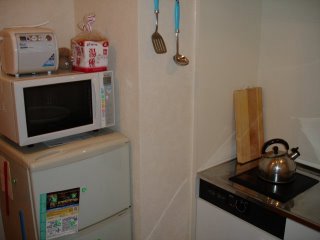
To cook anything more complicated than a bowl of instant ramen sometimes requires a carefully sequenced shifting of pots or plates from one place to another.
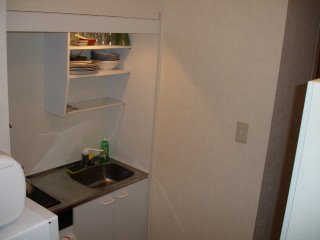
Through the kitchen is a long narrow hallway which leads to the front door:
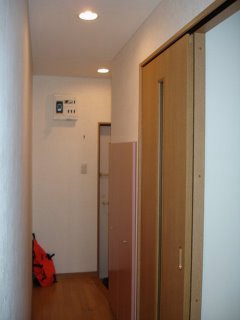
Off of the hall is one door, which opens into a small space which holds my washing machine.

And finally, off of that space is the door for my tiny cellular bathroom:

And that's it for the inside. I have a small balcony just wide enough to stand on, with a somewhat less than exciting city view:

This month there is additional excitement off my balcony to the left-- They've been knocking down a 6-story building, a chunk at a time, it seems.
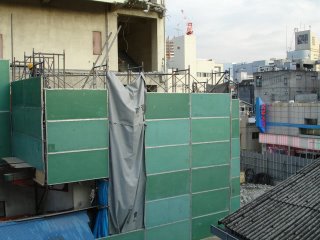
Here's a view of the fun from the next street over:

Luckily, I'm already up and around by the time the construction starts, so it doesn't really bother me. I suppose another building will go up, hopefully a little more pleasant to look at than the rust-stained wall that was there before. My view certainly doesn't compare to the one I had last year in Tottori:


I do miss Tottori sometimes... 懐かしい。。。
登録:
投稿 (Atom)


